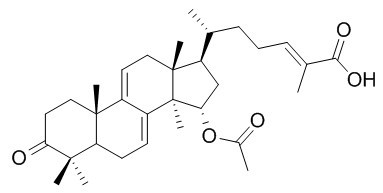Ganoderic acid T-Q
Ganoderic acid T-Q and TR are two inhibitors of H5N1 and H1N1 NAs.
Inquire / Order:
manager@chemfaces.com
Technical Inquiries:
service@chemfaces.com
Tel:
+86-27-84237783
Fax:
+86-27-84254680
Address:
1 Building, No. 83, CheCheng Rd., Wuhan Economic and Technological Development Zone, Wuhan, Hubei 430056, PRC
Providing storage is as stated on the product vial and the vial is kept tightly sealed, the product can be stored for up to
24 months(2-8C).
Wherever possible, you should prepare and use solutions on the same day. However, if you need to make up stock solutions in advance, we recommend that you store the solution as aliquots in tightly sealed vials at -20C. Generally, these will be useable for up to two weeks. Before use, and prior to opening the vial we recommend that you allow your product to equilibrate to room temperature for at least 1 hour.
Need more advice on solubility, usage and handling? Please email to: service@chemfaces.com
The packaging of the product may have turned upside down during transportation, resulting in the natural compounds adhering to the neck or cap of the vial. take the vial out of its packaging and gently shake to let the compounds fall to the bottom of the vial. for liquid products, centrifuge at 200-500 RPM to gather the liquid at the bottom of the vial. try to avoid loss or contamination during handling.
Dermatologica Sinica2024, 42(1):p19-30.
Front Nutr.2024, 11:1409309.
The Journal of Animal & Plant Sciences.2020, 30(6):1366-1373
Molecules.2023, 28(13):4907.
Plants (Basel).2020, 9(11):1422.
Biochem Pharmacol. 2023, 210:115463.
Phytother Res.2023, 37(10):4587-4606.
Korean J. Food Preserv.2023, 30(4):663-668.
ACS Pharmacol Transl Sci.2024, 7(2):395-405.
Plant Physiol.2023, 193(3):1758-1771.
Related and Featured Products
Scientific Reports, 2015, 5:13194.
Inhibition of neuraminidase by Ganoderma triterpenoids and implications for neuraminidase inhibitor design.[Reference:
WebLink]
Neuraminidase (NA) inhibitors are the dominant antiviral drugs for treating influenza in the clinic. Increasing prevalence of drug resistance makes the discovery of new NA inhibitors a high priority.
METHODS AND RESULTS:
Thirty-one triterpenoids from the medicinal mushroom Ganoderma lingzhi were analyzed in an in vitro NA inhibition assay, leading to the discovery of Ganoderic acid T-Q and TR as two inhibitors of H5N1 and H1N1 NAs. Structure-activity relationship studies revealed that the corresponding triterpenoid structure is a potential scaffold for the design of NA inhibitors. Using these triterpenoids as probes we found, through further in silico docking and interaction analysis, that interactions with the amino-acid residues Arg292 and/or Glu119 of NA are critical for the inhibition of H5N1 and H1N1.
CONCLUSIONS:
These findings should prove valuable for the design and development of NA inhibitors.
Journal of Natural Medicines,2018, 72(3):734-744.
Changes in content of triterpenoids and polysaccharides in Ganoderma lingzhi at different growth stages.[Reference:
WebLink]
Ganoderma lingzhi is a traditional medicinal mushroom, and its extract contains many bioactive compounds. Triterpenoids and polysaccharides are the primary bioactive components that contribute to its medicinal properties.
METHODS AND RESULTS:
In this study, we quantified 18 triterpenoids, total triterpenoid content and total polysaccharide content in the ethanol and water extracts of G. lingzhi at different growth stages. Triterpenoids were quantified by liquid chromatograph-tandem mass spectrometry in the multiple-reaction-monitoring mode. Total triterpenoid and total polysaccharide content were determined by colorimetric analysis. The results indicated that the fruit bodies at an early growth stage had a higher content of ganoderic acid A, C2, I and LM2, as well as of ganoderenic acid C and D, than those at a later growth stage. In contrast, ganoderic acid K, ganoderic acid TN and Ganoderic acid T-Q contents were higher in mature fruit bodies (maturation stage). The highest total triterpenoid and total polysaccharide contents were found in fruit bodies before maturity (stipe elongation stage or early stage of pileus formation).
CONCLUSIONS:
Our results provide information which will contribute to the establishment of an efficient cultivation system for G. lingzhi with a higher content of triterpenoids.



